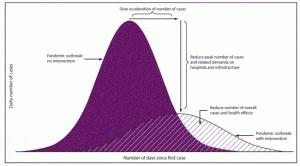COVID-19: Know the Facts!
In our March 19th statement on COVID-19 Community Resources, we urged the Pace community to know the facts about the virus. Recognizing that factual information is key for combating misinformation, panic, and discrimination, CCAR Student Projects Coordinator Valerie Eristil is here to explain the science behind the virus in an accessible manner! Valerie is a graduating senior Biology major here at Pace’s Pleasantville campus and she felt passionate about making sure the Pace Community was educated on this topic. Here is what she had to say:
It is the topic dominating the news cycle, social media, and almost every conversation you’ve had in the past three weeks: Coronavirus.
First and foremost: What is the Coronavirus?
Well, contrary to popular belief, coronavirus does not refer to one viral disease but rather a family of viruses, commonly found in people and in certain animals including cats, cattle, camels, and bats. The novel form of coronavirus currently taking over our everyday lives is called Coronavirus Disease 2019, or COVID-19 for short.
This form of coronavirus is similar to SARS and MERS in makeup and source. Coronavirus diseases commonly cause upper respiratory tract illnesses and COVID-19 is no different in that respect. Symptoms include fever, cough, or shortness of breath. COVID-19 is spread from person-to-person via droplets from coughing and sneezing. The CDC has noted that in severe cases symptoms also include trouble breathing, persistent pain or pressure in the chest, inability to arouse, or a bluish color in the lips/face. Individuals with severe symptoms should seek immediate medical attention. Those who have immunodeficiencies, underlying health issues, or are above 65 are at risk of severe illness caused by COVID-19. The CDC recommends those individuals refrain from leaving their homes at this time. Drive-in testing sites are being opened around New York and are operating on an appointment-only basis. Results can take any time between a few hours and 3-4 days. Visit your state’s Department of Health website for testing site locations and information.
Now that we know what COVID-19 is, let’s briefly discuss where it came from.
The short answer is scientists really don’t know for sure. There’s plenty of speculation but nothing definitive and, considering the present circumstances, that information isn’t very important since the healthcare community is working hard on slowing the spread and developing treatment. Here are the facts: COVID-19 comes from a betacoronavirus found in bats. The first documented cases were found in the Wuhan province of China.
An unfortunate development contrived from these two facts is a rise in stigma and prejudice against Chinese people. Media outlets and the current administration have referred to this virus as the “Chinese Virus” and made baseless claims about the spread of the virus being caused by people eating bat soup or that the virus was created in a bioweapons lab. These are, of course, false but has nonetheless led to a rise in xenophobia towards Asian people. It is important to be mindful of the facts and be aware that no one is “to blame” for this pandemic. Pandemics arise almost once a generation due to ecological and climate changes. No one person or population can be held responsible.
A month ago, this issue seemed far off and not relevant to our country. Now, as the number of cases continues to rise, it is important to understand what is being done on a local, state, and federal level. According to the CDC, as of March 23, there are 33,404 confirmed cases in the United States and 400 deaths. These numbers include all 50 states, the District of Columbia, Guam, and Puerto Rico. Of these cases, 449 are confirmed to be directly travel-related, 539 are due to close contact, and the remaining 32,416 are still under investigation.
The main goal is to slow community spread. I’m sure by now, we’ve all heard the phrase “flatten the curve.” The curve refers to the projected number of people who will  be infected over a period of time, shown by the graph courtesy of the CDC. As you can see, a rapid pandemic outbreak with no intervention leads to a large curve in the graph, representing the large number of people who will require treatment. The healthcare community can not accommodate the needs of such a large number of people in a short amount of time. We want to flatten this curve in order to allow health professionals to not be overwhelmed and ensure there will be no shortage of supplies necessary for treatment, including testing kits and protection for health professionals.
be infected over a period of time, shown by the graph courtesy of the CDC. As you can see, a rapid pandemic outbreak with no intervention leads to a large curve in the graph, representing the large number of people who will require treatment. The healthcare community can not accommodate the needs of such a large number of people in a short amount of time. We want to flatten this curve in order to allow health professionals to not be overwhelmed and ensure there will be no shortage of supplies necessary for treatment, including testing kits and protection for health professionals.
Now, I know what your next question will be: “How exactly do we flatten the curve?”
Well, there are plenty of ways to do that. As the testing kits become increasingly available, the number of cases in the country will rise. The CDC recommends that if you are sick, stay home. New York State has banned all nonessential travel and those in the nonessential workforce are to work from home for the time being. All schools, like Pace, have transitioned to online learning. Avoid gatherings for the time being (sorry, no house parties!), remember to cover your mouth with your elbow or a tissue if you cough or sneeze, and only go out for necessities like groceries and medication or in the case of an emergency. Wash your hands often and for at least 20 seconds. I recommend singing the chorus of ‘Love on Top’ by Beyonce, ‘Toxic’ by Britney Spears, or ‘No Scrubs’ by TLC. Use hand sanitizer (with at least 60% alcohol) when soap and water are not readily available and avoid touching your face. Face masks, while helpful if you are sick, are not to be used if you show no symptoms as there is a shortage of supplies for health professionals. Clean and disinfect surfaces frequently. This includes your phone, laptop, and kitchen counter! Stop the stigma. Avoid spreading misinformation by referring only to credible sources like the CDC’s website. Check the sources on any articles you read and be aware of click-bait! Practice self-care by limiting the amount of time you spend watching the news or on social media. Staying home during this time can be hard so make sure to take care of your mental health as well as your physical health. Go for walks (while practicing social distancing!), exercise at home, or read a book.
Stay safe and healthy everyone!
For more reputable information about COVID-19, and the Pace University and New York area response, see the below resources:






